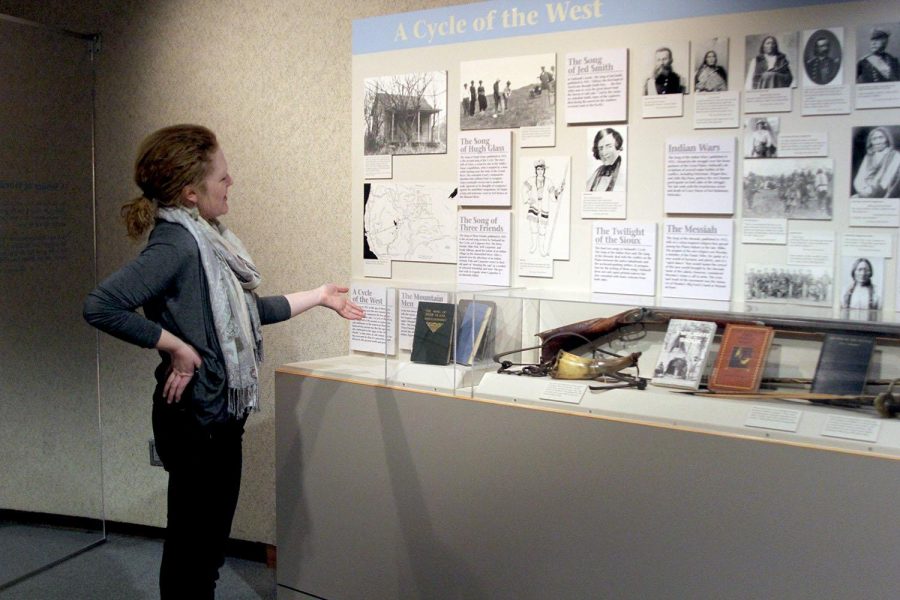The six degrees of separation of John G. Neihardt
The connection between Wayne State College and Leonardo DiCaprio
Amy Kucera, executive director of the Neihardt State Historic Site, pointed to some historical artifacts from John G. Neihardt’s time. Neihardt wrote an epic, “The Song of Hugh Glass,” in 1915
January 20, 2016
“The Revenant” cleaned up at the Golden Globes and probably will do the same at the Oscars, as Leonardo DiCaprio looks to finally get off the Oscar schnide.
Did you know the blockbuster has a unique connection to Wayne State?
DiCaprio plays the legendary frontiersman Hugh Glass, the man who famously survived a bear attack while on a fur-trapping expedition before being left for dead by the two men who were to stay back and care for him. Glass was somehow able to trek hundreds of miles and meet back up with his crew, who all thought he had died.
John G. Neihardt, Nebraska’s poet laureate, and graduate of what was formerly known as Wayne Normal School in 1897, was the first writer to tell the phenomenal tale of Glass in his epic “The Song of Hugh Glass,” in 1915, roughly a century after his legendary story happened.
Though the film was based off a 2002 novel of the same name and is slightly different than the original story, the film and Neihardt’s original work still share plenty of parallels.
Neihardt’s writing covered a time of American history that is often overlooked—the nearly 100 years between the Declaration of Independence and start of the Civil War—that was spent on westward expansion. There were many dynamics between Americans, the French and the Native Americans.
Through Neihardt’s research of this time period, the legend of Glass was one that he felt needed to be told.
“Neihardt explored the themes of the American west—the characters, the places, the people,” said Amy Kucera, executive director of the Neihardt State Historic Site in nearby Bancroft. “Through his research of other works, and wanting to capture all sides of the American west, this story appealed to him.”
The exposure that has been placed on the story has given Neihardt a bit of an increase in his posthumous fame.
“It has shone the spotlight on him and reiterated why he is important now,” Kucera said. “We have seen a spike in interest from both the public and the media, with media from all over the world having contacted us.”
It is worth mentioning that Neihardt’s close friend, Native American Black Elk, the subject of Neihardt’s most popular work, “Black Elk Speaks,” has also been back in the news.
Harney Peak, the highest point of the Black Hills in South Dakota, will be renamed after Black Elk this year. WSC alumnus Herb Mignery is working on a sculpture of Neihardt and Black Elk as a way to celebrate this, and the sculpture will be presented at the Neihardt State Historic Site on Neihardt day–the first Sunday in August.
As for what the accomplished poet would have thought of the film, “I think he would be excited that the era in which he explored is relevant again to an even wider audience through another art form,” said Kucera, a WSC graduate herself and a Wayne Stater editor.
Whether or not DiCaprio will finally earn his Best Actor Oscar remains to be seen. But one thing is for sure—one of the most talented actors of the century will forever hold a distinctive connection to WSC.










